We can group the resultset in SQL on multiple column values. All the column values defined as grouping criteria should match with other records column values to group them to a single record. Though both are used to exclude rows from the result set, you should use the WHERE clause to filter rows before grouping and use the HAVING clause to filter rows after grouping. In other words, WHERE can be used to filter on table columns while HAVING can be used to filter on aggregate functions like count, sum, avg, min, and max. Grouping on multiple columns is most often used for generating queries for reports, dashboarding, etc.
Group by is done for clubbing together the records that have the same values for the criteria that are defined for grouping. Let us use the aggregate functions in the group by clause with multiple columns. This means given for the expert named Payal, two different records will be retrieved as there are two different values for session count in the table educba_learning that are 750 and 950. Expression_n Expressions that are not encapsulated within an aggregate function and must be included in the GROUP BY Clause at the end of the SQL statement. Aggregate_function This is an aggregate function such as the SUM, COUNT, MIN, MAX, or AVG functions. Aggregate_expression This is the column or expression that the aggregate_function will be used on.
There must be at least one table listed in the FROM clause. These are conditions that must be met for the records to be selected. The expression used to sort the records in the result set. If more than one expression is provided, the values should be comma separated.
ASC sorts the result set in ascending order by expression. DESC sorts the result set in descending order by expression. ROLLUP is an extension of the GROUP BY clause that creates a group for each of the column expressions. Additionally, it "rolls up" those results in subtotals followed by a grand total.
Under the hood, the ROLLUP function moves from right to left decreasing the number of column expressions that it creates groups and aggregations on. Since the column order affects the ROLLUP output, it can also affect the number of rows returned in the result set. The GROUP BY clause groups a set of rows into a set of summary rows by values of columns or expressions. In other words, it reduces the number of rows in the result set. The Group by Clause in SQL Server is used to divide similar types of records or data as a group and then return. If we use group by clause in the query then we should use grouping/aggregate function such as count(), sum(), max(), min(), and avg() functions.
The GROUP BY clause is often used with aggregate functions such as AVG(), COUNT(), MAX(), MIN() and SUM(). In this case, the aggregate function returns the summary information per group. For example, given groups of products in several categories, the AVG() function returns the average price of products in each category.
You must use the aggregate functions such as COUNT(), MAX(), MIN(), SUM(), AVG(), etc., in the SELECT query. The result of the GROUP BY clause returns a single row for each value of the GROUP BY column. The GROUP BY clause is a SQL command that is used to group rows that have the same values. Optionally it is used in conjunction with aggregate functions to produce summary reports from the database. The Group by clause is often used to arrange identical duplicate data into groups with a select statement to group the result-set by one or more columns.
This clause works with the select specific list of items, and we can use HAVING, and ORDER BY clauses. Group by clause always works with an aggregate function like MAX, MIN, SUM, AVG, COUNT. To this point, I've used aggregate functions to summarize all the values in a column or just those values that matched a WHERE search condition. You can use the GROUP BY clause to divide a table into logical groups and calculate aggregate statistics for each group.
An aggregate function takes multiple rows as an input and returns a single value for these rows. Some commonly used aggregate functions are AVG(), COUNT(), MIN(), MAX() and SUM(). For example, the COUNT() function returns the number of rows for each group. The AVG() function returns the average value of all values in the group. The OVER clause defines a window or user-specified set of rows within a query result set.
A window function then computes a value for each row in the window. You can use the OVER clause with functions to compute aggregated values such as moving averages, cumulative aggregates, running totals, or a top N per group results. You can use the SQL PARTITION BY clause with the OVER clause to specify the column on which we need to perform aggregation. PARTITION BY gives aggregated columns with each record in the specified table. If we have 15 records in the table, the query output SQL PARTITION BY also gets 15 rows. On the other hand, GROUP BY gives one row per group in result set.
The GROUP BY clause is used in a SELECT statement to group rows into a set of summary rows by values of columns or expressions. Adding a HAVING clause after your GROUP BY clause requires that you include any special conditions in both clauses. If the SELECT statement contains an expression, then it follows suit that the GROUP BY and HAVING clauses must contain matching expressions. It is similar in nature to the "GROUP BY with an EXCEPTION" sample from above. In the next sample code block, we are now referencing the "Sales.SalesOrderHeader" table to return the total from the "TotalDue" column, but only for a particular year. The above query includes the GROUP BY DeptId clause, so you can include only DeptId in the SELECT clause.
You need to use aggregate functions to include other columns in the SELECT clause, so COUNT is included because we want to count the number of employees in the same DeptId. The GROUP BY clause arranges rows into groups and an aggregate function returns the summary (count, min, max, average, sum, etc.,) for each group. The aggregate functions allow you to perform the calculation of a set of rows and return a single value. The GROUP BY clause is often used with an aggregate function to perform calculations and return a single value for each subgroup. FILTER is a modifier used on an aggregate function to limit the values used in an aggregation.
All the columns in the select statement that aren't aggregated should be specified in a GROUP BY clause in the query. Like most things in SQL/T-SQL, you can always pull your data from multiple tables. Performing this task while including a GROUP BY clause is no different than any other SELECT statement with a GROUP BY clause.
The fact that you're pulling the data from two or more tables has no bearing on how this works. In the sample below, we will be working in the AdventureWorks2014 once again as we join the "Person.Address" table with the "Person.BusinessEntityAddress" table. I have also restricted the sample code to return only the top 10 results for clarity sake in the result set. In the Group BY clause, the SELECT statement can use constants, aggregate functions, expressions, and column names. However, you can use the GROUP BY clause with CUBE, GROUPING SETS, and ROLLUP to return summary values for each group.
When you start learning SQL, you quickly come across the GROUP BY clause. Data grouping—or data aggregation—is an important concept in the world of databases. In this article, we'll demonstrate how you can use the GROUP BY clause in practice.
We've gathered five GROUP BY examples, from easier to more complex ones so you can see data grouping in a real-life scenario. As a bonus, you'll also learn a bit about aggregate functions and the HAVING clause. The SELECT statement used in the GROUP BY clause can only be used contain column names, aggregate functions, constants and expressions. When selecting groups of rows from the database, we are interested in the characteristics of the groups, not individual rows. Therefore, we often use aggregate functions in conjunction with the GROUP BY clause. The GROUP BY clause divides the rows returned from the SELECTstatement into groups.
For each group, you can apply an aggregate function e.g.,SUM() to calculate the sum of items or COUNT()to get the number of items in the groups. Contrary to what most books and classes teach you, there are actually 9 aggregate functions, all of which can be used with a GROUP BY clause in your code. As we have seen in the samples above, you can have a GROUP BY clause without an aggregate function as well. As we demonstrated earlier in this article, the GROUP BY clause can group string values also, so it doesn't always have to be a numeric or date value. As you can see in the result set above, the query has returned all groups with unique values of , , and . The NULL NULL result set on line 11 represents the total rollup of all the cubed roll up values, much like it did in the GROUP BY ROLLUP section from above.
Another extension, or sub-clause, of the GROUP BY clause is the CUBE. The CUBE generates multiple grouping sets on your specified columns and aggregates them. In short, it creates unique groups for all possible combinations of the columns you specify.
For example, if you use GROUP BY CUBE on of your table, SQL returns groups for all unique values , , and . The SUM() function returns the total value of all non-null values in a specified column. Since this is a mathematical process, it cannot be used on string values such as the CHAR, VARCHAR, and NVARCHAR data types. When used with a GROUP BY clause, the SUM() function will return the total for each category in the specified table.
In the sample below, we will return a list of the "CountryRegionName" column and the "StateProvinceName" from the "Sales.vSalesPerson" view in the AdventureWorks2014 sample database. In the first SELECT statement, we will not do a GROUP BY, but instead, we will simply use the ORDER BY clause to make our results more readable sorted as either ASC or DESC. IIt is important to note that using a GROUP BY clause is ineffective if there are no duplicates in the column you are grouping by. A better example would be to group by the "Title" column of that table.
The SELECT clause below will return the six unique title types as well as a count of how many times each one is found in the table within the "Title" column. WE can use aggregate functions like sum, min, max, avg, etc with the HAVING clause but they can never be used with WHERE clause. We'll call columns/expressions that are in SELECT without being in an aggregate function, nor in GROUP BY,barecolumns. In other words, if our results include a column that we're not grouping by and we're also not performing any kind of aggregation or calculation on it, that's a bare column. Listing 6.12 and Figure 6.12 show a simple GROUP BY query that calculates the total sales, average sales, and number of titles for each type of book.
In Listing 6.13 and Figure 6.13, I've added a WHERE clause to eliminate books priced under $13 before grouping. I've also added an ORDER BY clause to sort the result by descending total sales of each book type. If the statement includes a WHERE clause, the DBMS groups values after it applies search_condition to the rows in table. If the statement includes an ORDER BY clause, the columns in sort_columns must be drawn from those in columns. The WHERE and ORDER BY clauses are covered in "Filtering Rows with WHERE" and "Sorting Rows with ORDER BY" in Chapter 4.
HAVING, which filters grouped rows, is covered in the next section. We can observe that for the expert named Payal two records are fetched with session count as 1500 and 950 respectively. Note that the aggregate functions are used mostly for numeric valued columns when group by clause is used.
Criteriacolumn1 , criteriacolumn2,…,criteriacolumnj – These are the columns that will be considered as the criteria to create the groups in the MYSQL query. There can be single or multiple column names on which the criteria need to be applied. SQL does not allow using the alias as the grouping criteria in the GROUP BY clause. Note that multiple criteria of grouping should be mentioned in a comma-separated format. This syntax allows users to perform analysis that requires aggregation on multiple sets of columns in a single query. Complex grouping operations do not support grouping on expressions composed of input columns.
Notice that any column listed in the select list that is not in the aggregate function expression must be placed in the GROUP BY clause, or you will get an error. Though it's not required by SQL, it is advisable to include all non-aggregated columns from your SELECT clause in your GROUP BY clause. Use the GROUP BY clause with aggregate functions in a SELECT statement to collect data across multiple records. The GROUP BY clause is used to get the summary data based on one or more groups. For example, the GROUP BY query will be used to count the number of employees in each department, or to get the department wise total salaries. An aggregate function performs a calculation on a group and returns a unique value per group.
Can We Use Group By With Where Clause In Sql For example, COUNT() returns the number of rows in each group. Other commonly used aggregate functions are SUM(), AVG() , MIN() , MAX() . In this lesson you learned to use the SQL GROUP BY and aggregate functions to increase the power expressivity of the SQL SELECT statement. You know about the collapse issue, and understand you cannot reference individual records once the GROUP BY clause is used.
The GROUP BY statement is often used with aggregate functions (COUNT(),MAX(),MIN(), SUM(),AVG()) to group the result-set by one or more columns. When an aggregate function is used in the SELECT list, all non-aggregate columns or expressions in the SELECT list must be specified as grouping columns in the GROUP BY clause. The multiple values returned by an aggregate function in a GROUP BY query are called vector aggregates. In a query that lacks a GROUP BY clause, the single value returned by an aggregate function is a scalar aggregate.
Aggregate_function – These are the aggregate functions defined on the columns of target_table that needs to be retrieved from the SELECT query. A GROUP BY statement in SQL specifies that a SQL SELECT statement partitions result rows into groups, based on their values in one or several columns. Typically, grouping is used to apply some sort of aggregate function for each group. In addition to columns, you can group rows by expressions. In this syntax, you place the GROUP BY clause after the FROM and WHERE clauses.
After the GROUP BY keywords, you place is a list of comma-separated columns or expressions to group rows. GROUP BY enables you to use aggregate functions on groups of data returned from a query. That means first Group By clause is used to divide similar types of data as a group and then an aggregate function is applied to each group to get the required results. This is because the where statement is evaluated before any aggregations take place. The alternate having is placed after the group by and allows you to filter the returned data by an aggregated column. The MIN() function returns the smallest value in the column specified.
An ORDER BY clause was not used in this sample and as you can see there is no order to the result set. If you need to use an ORDER BY clause, it must follow the GROUP BY clause. The other item you may notice in the above query, is that we used a WHERE filter to cull out any rows that are NULL.

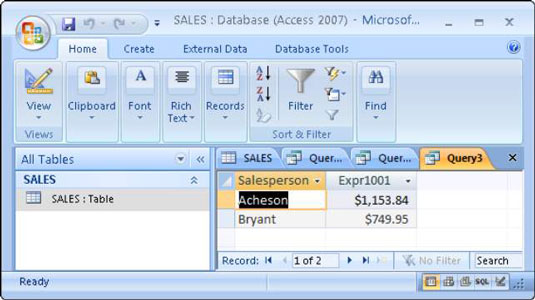



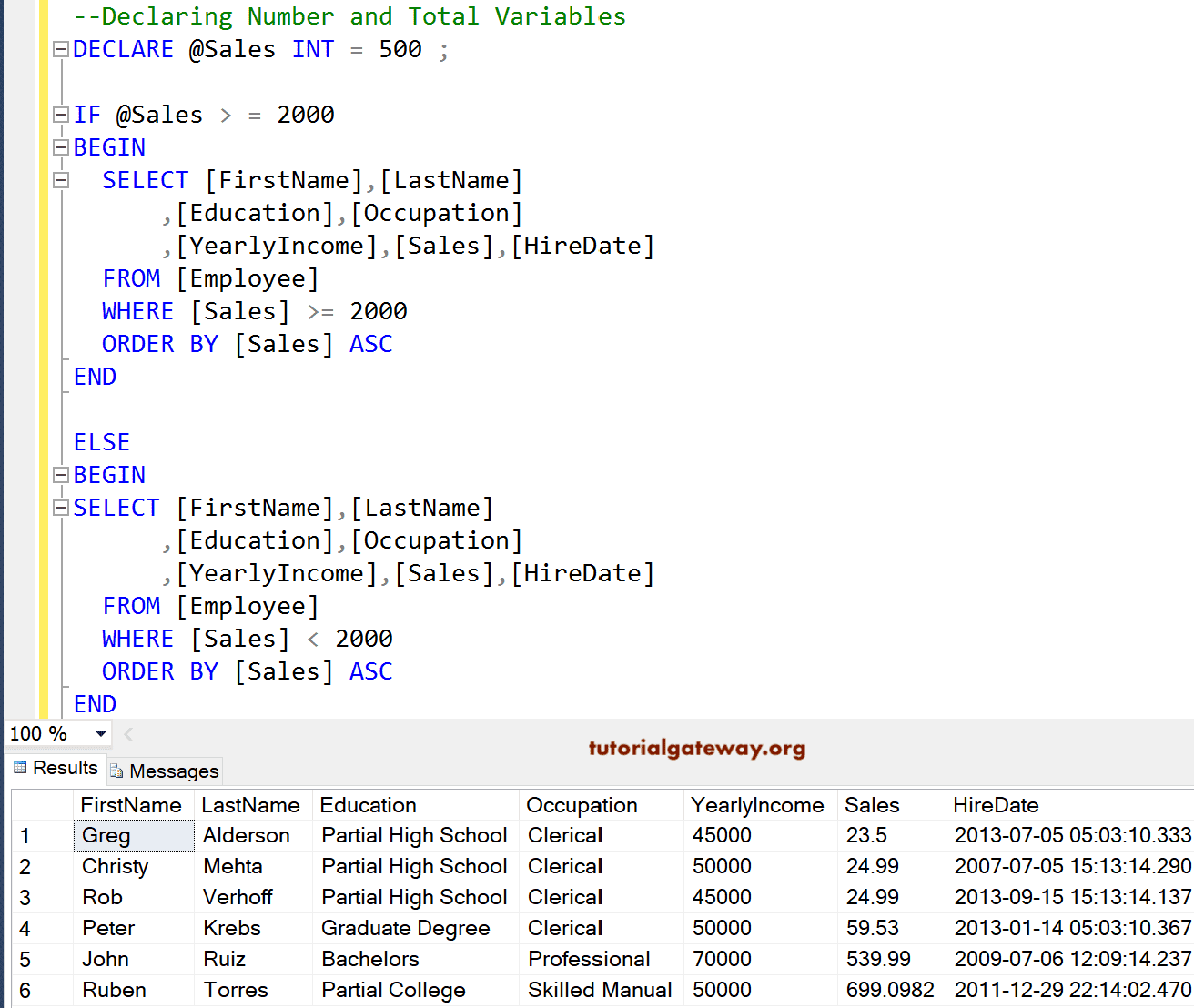




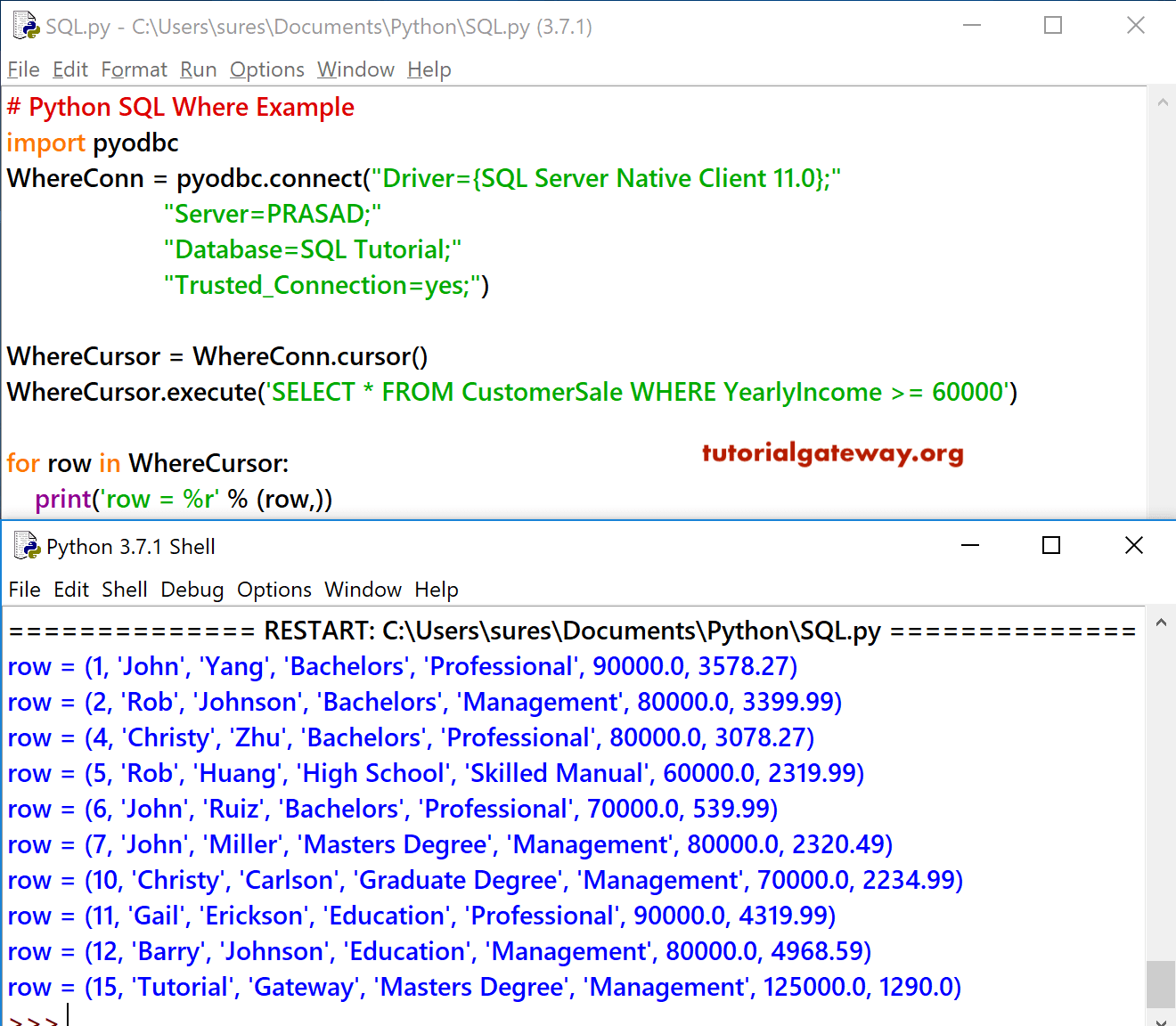
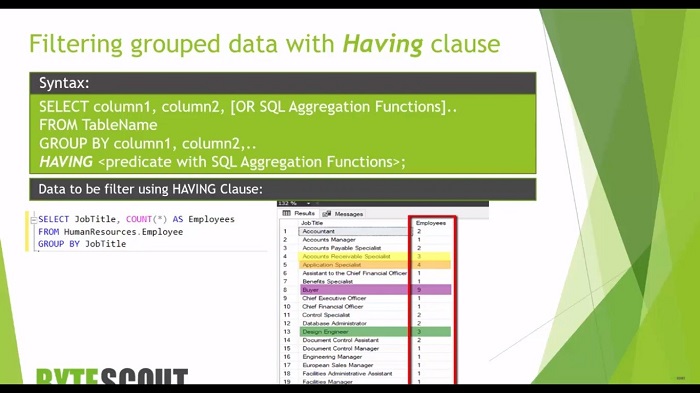




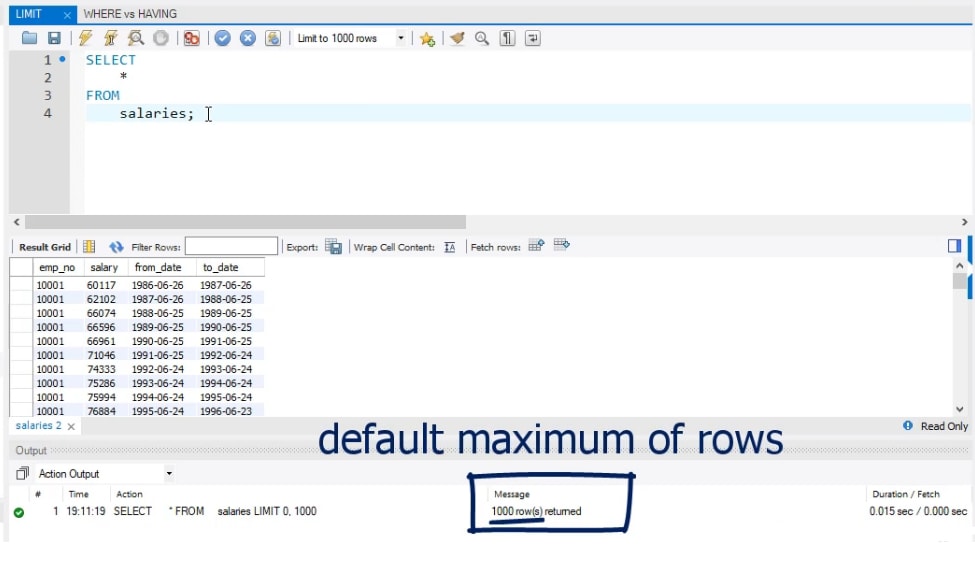





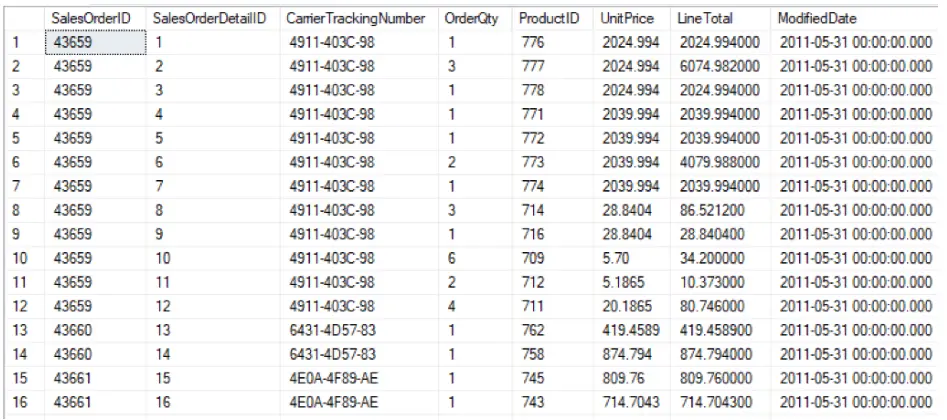



No comments:
Post a Comment
Note: Only a member of this blog may post a comment.